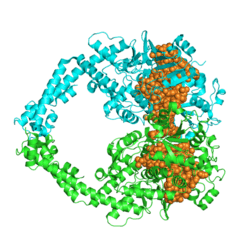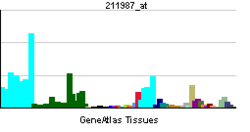TOP2B
| View/Edit Human | View/Edit Mouse |
DNA topoisomerase 2-beta is an enzyme that in humans is encoded by the TOP2B gene.[3][4]
Function
This gene encodes a DNA topoisomerase, an enzyme that controls and alters the topologic states of DNA during transcription. This nuclear enzyme is involved in processes such as chromosome condensation, chromatid separation, and the relief of torsional stress that occurs during DNA transcription and replication. It catalyzes the transient breaking and rejoining of two strands of duplex DNA which allows the strands to pass through one another, thus altering the topology of DNA. Two forms of this enzyme exist as likely products of a gene duplication event. The gene encoding this form, beta, is localized to chromosome 3 and the alpha form is localized to chromosome 17. The gene encoding this enzyme functions as the target for several anticancer agents, for example mitoxantrone, and a variety of mutations in this gene have been associated with the development of drug resistance. Reduced activity of this enzyme may also play a role in ataxia-telangiectasia. Alternative splicing of this gene results in two transcript variants; however, the second variant has not yet been fully described.[5]
Interactions
TOP2B has been shown to interact with:
References
- ↑ "Human PubMed Reference:".
- ↑ "Mouse PubMed Reference:".
- ↑ Tan KB, Dorman TE, Falls KM, Chung TD, Mirabelli CK, Crooke ST, Mao J (Jan 1992). "Topoisomerase II alpha and topoisomerase II beta genes: characterization and mapping to human chromosomes 17 and 3, respectively". Cancer Research. 52 (1): 231–4. PMID 1309226.
- ↑ Jenkins JR, Ayton P, Jones T, Davies SL, Simmons DL, Harris AL, Sheer D, Hickson ID (Nov 1992). "Isolation of cDNA clones encoding the beta isozyme of human DNA topoisomerase II and localisation of the gene to chromosome 3p24". Nucleic Acids Research. 20 (21): 5587–92. doi:10.1093/nar/20.21.5587. PMC 334390
 . PMID 1333583.
. PMID 1333583. - ↑ "Entrez Gene: TOP2B topoisomerase (DNA) II beta 180kDa".
- ↑ Kitagawa H, Fujiki R, Yoshimura K, Mezaki Y, Uematsu Y, Matsui D, Ogawa S, Unno K, Okubo M, Tokita A, Nakagawa T, Ito T, Ishimi Y, Nagasawa H, Matsumoto T, Yanagisawa J, Kato S (Jun 2003). "The chromatin-remodeling complex WINAC targets a nuclear receptor to promoters and is impaired in Williams syndrome". Cell. 113 (7): 905–17. doi:10.1016/s0092-8674(03)00436-7. PMID 12837248.
- 1 2 Tsai SC, Valkov N, Yang WM, Gump J, Sullivan D, Seto E (Nov 2000). "Histone deacetylase interacts directly with DNA topoisomerase II". Nature Genetics. 26 (3): 349–53. doi:10.1038/81671. PMID 11062478.
- ↑ Johnson CA, Padget K, Austin CA, Turner BM (Feb 2001). "Deacetylase activity associates with topoisomerase II and is necessary for etoposide-induced apoptosis". The Journal of Biological Chemistry. 276 (7): 4539–42. doi:10.1074/jbc.C000824200. PMID 11136718.
- ↑ Cowell IG, Okorokov AL, Cutts SA, Padget K, Bell M, Milner J, Austin CA (Feb 2000). "Human topoisomerase IIalpha and IIbeta interact with the C-terminal region of p53". Experimental Cell Research. 255 (1): 86–94. doi:10.1006/excr.1999.4772. PMID 10666337.
- ↑ Mao Y, Desai SD, Liu LF (Aug 2000). "SUMO-1 conjugation to human DNA topoisomerase II isozymes". The Journal of Biological Chemistry. 275 (34): 26066–73. doi:10.1074/jbc.M001831200. PMID 10862613.
- ↑ Nakano H, Yamazaki T, Miyatake S, Nozaki N, Kikuchi A, Saito T (Mar 1996). "Specific interaction of topoisomerase II beta and the CD3 epsilon chain of the T cell receptor complex". The Journal of Biological Chemistry. 271 (11): 6483–9. doi:10.1074/jbc.271.11.6483. PMID 8626450.
Further reading
- Champoux JJ (2002). "DNA topoisomerases: structure, function, and mechanism". Annual Review of Biochemistry. 70: 369–413. doi:10.1146/annurev.biochem.70.1.369. PMID 11395412.
- Austin CA, Fisher LM (Jun 1990). "Isolation and characterization of a human cDNA clone encoding a novel DNA topoisomerase II homologue from HeLa cells". FEBS Letters. 266 (1-2): 115–7. doi:10.1016/0014-5793(90)81520-X. PMID 2163884.
- Chung TD, Drake FH, Tan KB, Per SR, Crooke ST, Mirabelli CK (Dec 1989). "Characterization and immunological identification of cDNA clones encoding two human DNA topoisomerase II isozymes". Proceedings of the National Academy of Sciences of the United States of America. 86 (23): 9431–5. doi:10.1073/pnas.86.23.9431. PMC 298510
 . PMID 2556712.
. PMID 2556712. - Austin CA, Sng JH, Patel S, Fisher LM (Mar 1993). "Novel HeLa topoisomerase II is the II beta isoform: complete coding sequence and homology with other type II topoisomerases". Biochimica et Biophysica Acta. 1172 (3): 283–91. doi:10.1016/0167-4781(93)90215-Y. PMID 8383537.
- Davies SL, Jenkins JR, Hickson ID (Aug 1993). "Human cells express two differentially spliced forms of topoisomerase II beta mRNA". Nucleic Acids Research. 21 (16): 3719–23. doi:10.1093/nar/21.16.3719. PMC 309874
 . PMID 8396237.
. PMID 8396237. - Nakano H, Yamazaki T, Miyatake S, Nozaki N, Kikuchi A, Saito T (Mar 1996). "Specific interaction of topoisomerase II beta and the CD3 epsilon chain of the T cell receptor complex". The Journal of Biological Chemistry. 271 (11): 6483–9. doi:10.1074/jbc.271.11.6483. PMID 8626450.
- Biersack H, Jensen S, Gromova I, Nielsen IS, Westergaard O, Andersen AH (Aug 1996). "Active heterodimers are formed from human DNA topoisomerase II alpha and II beta isoforms". Proceedings of the National Academy of Sciences of the United States of America. 93 (16): 8288–93. doi:10.1073/pnas.93.16.8288. PMC 38663
 . PMID 8710863.
. PMID 8710863. - Meyer KN, Kjeldsen E, Straub T, Knudsen BR, Hickson ID, Kikuchi A, Kreipe H, Boege F (Feb 1997). "Cell cycle-coupled relocation of types I and II topoisomerases and modulation of catalytic enzyme activities". The Journal of Cell Biology. 136 (4): 775–88. doi:10.1083/jcb.136.4.775. PMC 2132491
 . PMID 9049244.
. PMID 9049244. - Fukunaga R, Hunter T (Apr 1997). "MNK1, a new MAP kinase-activated protein kinase, isolated by a novel expression screening method for identifying protein kinase substrates". The EMBO Journal. 16 (8): 1921–33. doi:10.1093/emboj/16.8.1921. PMC 1169795
 . PMID 9155018.
. PMID 9155018. - Ng SW, Liu Y, Schnipper LE (Dec 1997). "Cloning and characterization of the 5'-flanking sequence for the human DNA topoisomerase II beta gene". Gene. 203 (2): 113–9. doi:10.1016/S0378-1119(97)00500-3. PMID 9426241.
- Yamane K, Kawabata M, Tsuruo T (Dec 1997). "A DNA-topoisomerase-II-binding protein with eight repeating regions similar to DNA-repair enzymes and to a cell-cycle regulator". European Journal of Biochemistry / FEBS. 250 (3): 794–9. doi:10.1111/j.1432-1033.1997.00794.x. PMID 9461304.
- Cowell IG, Willmore E, Chalton D, Marsh KL, Jazrawi E, Fisher LM, Austin CA (Sep 1998). "Nuclear distribution of human DNA topoisomerase IIbeta: a nuclear targeting signal resides in the 116-residue C-terminal tail". Experimental Cell Research. 243 (2): 232–40. doi:10.1006/excr.1998.4150. PMID 9743583.
- Lang AJ, Mirski SE, Cummings HJ, Yu Q, Gerlach JH, Cole SP (Oct 1998). "Structural organization of the human TOP2A and TOP2B genes". Gene. 221 (2): 255–66. doi:10.1016/S0378-1119(98)00468-5. PMID 9795238.
- Sng JH, Heaton VJ, Bell M, Maini P, Austin CA, Fisher LM (Mar 1999). "Molecular cloning and characterization of the human topoisomerase IIalpha and IIbeta genes: evidence for isoform evolution through gene duplication". Biochimica et Biophysica Acta. 1444 (3): 395–406. doi:10.1016/S0167-4781(99)00020-2. PMID 10095062.
- Bjergbaek L, Jensen S, Westergaard O, Andersen AH (Sep 1999). "Using a biochemical approach to identify the primary dimerization regions in human DNA topoisomerase IIalpha". The Journal of Biological Chemistry. 274 (37): 26529–36. doi:10.1074/jbc.274.37.26529. PMID 10473615.
- Cowell IG, Okorokov AL, Cutts SA, Padget K, Bell M, Milner J, Austin CA (Feb 2000). "Human topoisomerase IIalpha and IIbeta interact with the C-terminal region of p53". Experimental Cell Research. 255 (1): 86–94. doi:10.1006/excr.1999.4772. PMID 10666337.
- Mao Y, Desai SD, Liu LF (Aug 2000). "SUMO-1 conjugation to human DNA topoisomerase II isozymes". The Journal of Biological Chemistry. 275 (34): 26066–73. doi:10.1074/jbc.M001831200. PMID 10862613.
- Mirski SE, Voskoglou-Nomikos T, Young LC, Deeley RG, Campling BG, Gerlach JH, Cole SP (Jun 2000). "Simultaneous quantitation of topoisomerase II alpha and beta isoform mRNAs in lung tumor cells and normal and malignant lung tissue". Laboratory Investigation. 80 (6): 787–95. doi:10.1038/labinvest.3780083. PMID 10879730.

